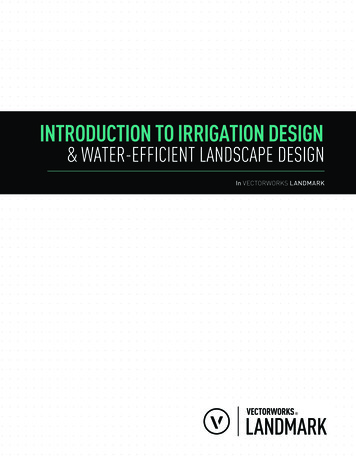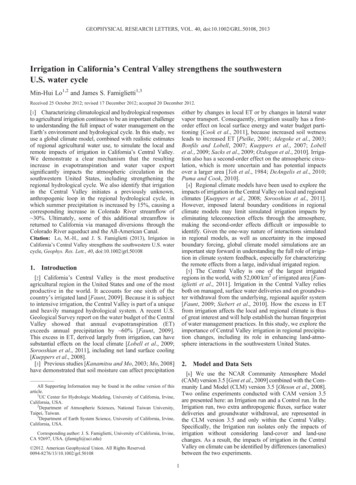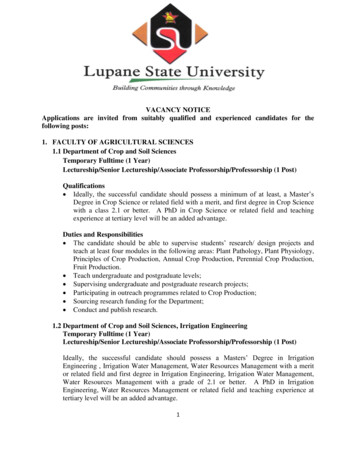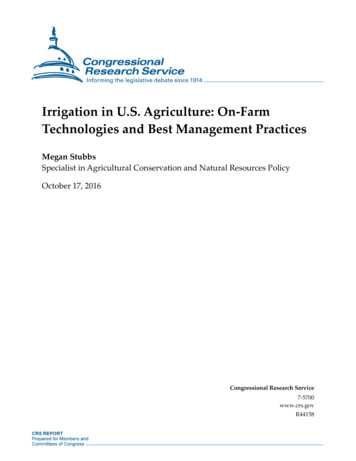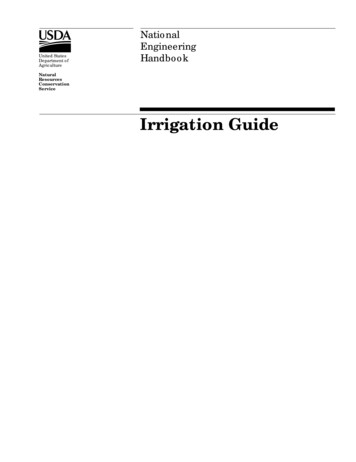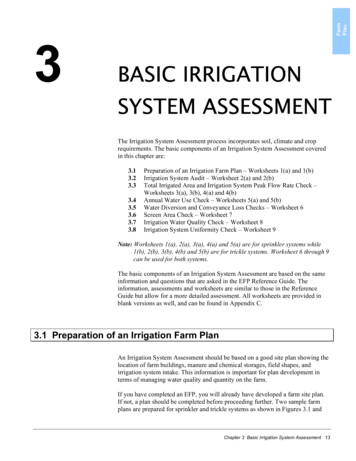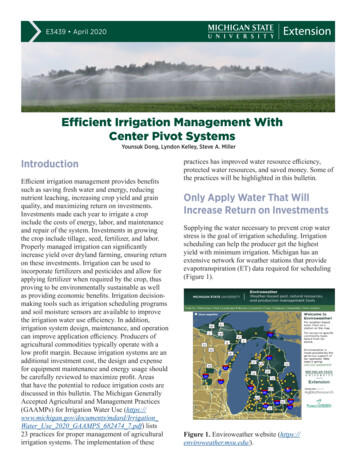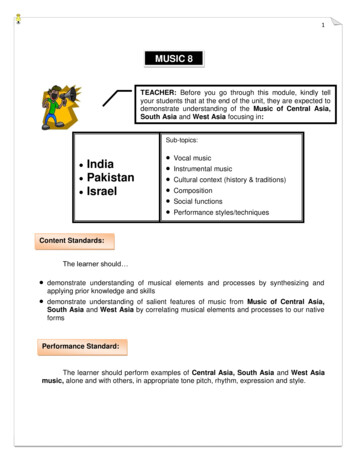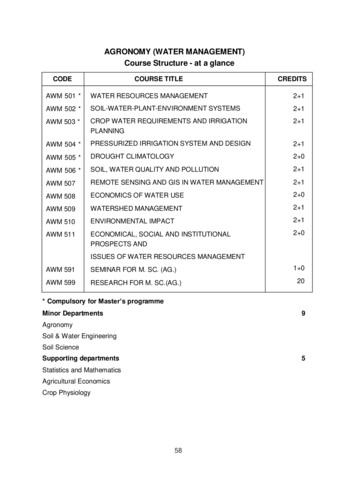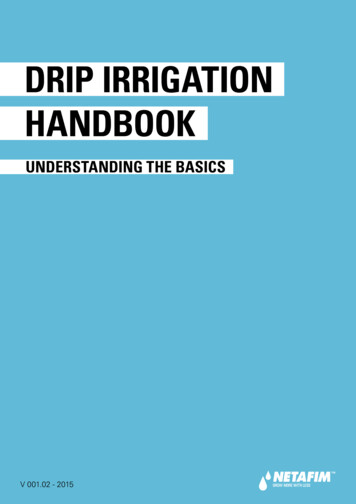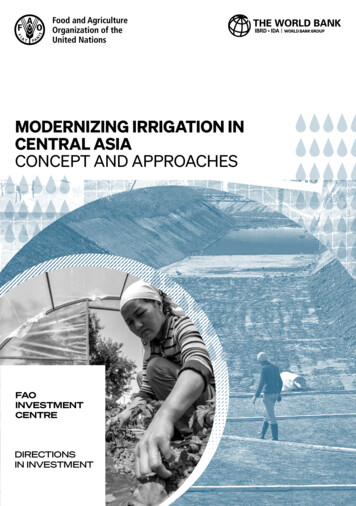
Transcription
MODERNIZING IRRIGATION INCENTRAL ASIACONCEPT AND APPROACHESFAOINVESTMENTCENTREDIRECTIONSIN INVESTMENT
Creative Commons CC BY-SA 4.0/Benjamin Goetzinger
Directions in InvestmentNumber 6MODERNIZING IRRIGATION INCENTRAL ASIACONCEPT AND APPROACHESRimma DankovaMartin BurtonMaher SalmanAlan K. ClarkEva PekThis work is a co-publication ofFood and Agriculture Organization of the United NationsandThe World BankRome, 2022
Required citation:Dankova, R., Burton, M., Salman, M., Clark, AK. & Pek, E. 2022. Modernizing irrigation in CentralAsia: concept and approaches. Directions in Investment, No. 6. Rome, FAO and The World Bank.https://doi.org/10.4060/cb8230enThe designations employed and the presentation of material in this information product do not implythe expression of any opinion whatsoever on the part of the Food and Agriculture Organization of theUnited Nations (FAO) or The World Bank concerning the legal or development status of any country,territory, city or area or of its authorities, or concerning the delimitation of its frontiers or boundaries.Dashed lines on maps represent approximate border lines for which there may not yet be fullagreement. The mention of specific companies or products of manufacturers, whether or not thesehave been patented, does not imply that these have been endorsed or recommended by FAO or TheWorld Bank in preference to others of a similar nature that are not mentioned.The views expressed in this information product are those of the author(s) and do not necessarilyreflect the views or policies of FAO or those of The World Bank, its Board of Executive Directors, orthe governments they represent.ISBN 978-92-5-135598-5 FAO and The World Bank, 2022Some rights reserved. This work is made available under the Creative Commons AttributionNonCommercial-ShareAlike 3.0 IGO licence (CC BY-NC-SA 3.0 IGO; igo/legalcode).Under the terms of this licence, this work may be copied, redistributed and adapted for noncommercial purposes, provided that the work is appropriately cited. In any use of this work, thereshould be no suggestion that FAO or The World Bank endorse any specific organization, productsor services. The use of the FAO and The World Bank logos is not permitted. If the work is adapted,then it must be licensed under the same or equivalent Creative Commons license. If a translation ofthis work is created, it must include the following disclaimer along with the required citation: “Thistranslation was not created by the Food and Agriculture Organization of the United Nations (FAO)or by The World Bank. Neither FAO nor the World Bank are responsible for the content or accuracyof this translation. The original English edition shall be the authoritative edition.”Disputes arising under the licence that cannot be settled amicably will be resolved by mediationand arbitration as described in Article 8 of the licence except as otherwise provided herein. Theapplicable mediation rules will be the mediation rules of the World Intellectual PropertyOrganization http://www.wipo.int/amc/en/mediation/rules and any arbitration will be inaccordance with the Arbitration Rules of the United Nations Commission on International TradeLaw (UNCITRAL).Third-party materials. Users wishing to reuse material from this work that is attributed to a thirdparty, such as tables, figures or images, are responsible for determining whether permission isneeded for that reuse and for obtaining permission from the copyright holder. The risk of claimsresulting from infringement of any third-party-owned component in the work rests solely with theuser.Sales, rights and licensing. FAO information products are available on the FAO website (www.fao.org/publications) and can be purchased through publications-sales@fao.org. Requests forcommercial use should be submitted via: www.fao.org/contact-us/licence-request. Queriesregarding rights and licensing should be submitted to: copyright@fao.orgArt direction and design: Reem AzzuCover photographs: FAO/Vyacheslav Oseledko Mark Svendsen
CONTENTSForewordAcknowledgementsAbbreviations and acronymsDefinitionsExecutive summaryVIVIIVIIIXXICHAPTER 1IntroductionCHAPTER 2Irrigation in Central AsiaClimate and natural resourcesAgricultureIrrigation and drainage systemsIrrigation and drainage institutionsCost recovery and financial sustainabilityEnvironmental issues5589111213CHAPTER 3Future prospects: drivers for change17CHAPTER 4Irrigation modernization: challenges and opportunities23CHAPTER 5A framework for modernizationDefinition of modernizationObjectives of modernizationIdentifying components of a modernization programModernization process3131333335CHAPTER 6Implementing irrigation modernization in Central Asia: key actionsand activitiesAction Area 1 - Policy and legislationAction Area 2 - Institutional reformAction Area 3 - System modernization for improved service deliveryAction Area 4 - Strengthening agricultureAction Area 5 - Upgrading knowledge and information414145465659CHAPTER 7Tailoring modernization interventions63CHAPTER 8Conclusions75References80Annex IAnnex IIAnnex IIIAnnex IVAnnex VAnnex VIFAO Rapid Appraisal Procedure (RAP) evaluations andrecommendationsTajikistan: issues and opportunitiesUzbekistan: issues and opportunitiesKazakhstan: issues and opportunitiesClimate resilient technologies and innovationsApproach to modernization: a performance-based managementprocess1848688919396
Tables, boxes and figuresTables2.1 Cultivable areas in the Aral Sea Basin72.2 Average annual renewable water resources in 201272.3 National water endowments72.4 Socio-economic characteristics of agriculture in Central Asia82.5 Yields of wheat and cotton, 2015–1882.6 Irrigation methods102.7 Drainage in irrigation areas104.1 Opportunities and actions for addressing issues facing the irrigationsector in Central Asia254.2 SWOT analysis for Central Asia countries to progress with irrigationmodernization265.1 Action Areas for irrigation and drainage sector modernization356.1 Possible components of a modernization programme – issues and activities427.164Possible categorization of I&D schemes and their level of performance7.2 Considerations in prioritizing modernization activities667.3 Possible components for modernization of an irrigation and drainagescheme67Tables in annexesII.18688IV.1 Kazakhstan: issues and opportunities91V.1 Climate resilient technologies and innovations93VI.1 Programme for benchmarking performance in the I&D sector97BoxesAction areas for irrigation and drainage sector modernizationXIII2.1 Key issues in the irrigation and drainage sector in Central Asia111.1IVTajikistan: issues and opportunitiesIII.1 Uzbekistan: issues and opportunities3.1 Projected impacts of climate change on water resources availabilityin Central Asia195.1 Definition of modernization325.2 Objectives of irrigation modernization in Central Asia335.3 Efficiency objectives and typical interventions346.1 Trends in agricultural policies in Central Asia446.2 Future possible modernization initiatives in Central Asia486.3 Adoption of modern management practices in Madhya Pradesh, India496.4 Costs and benefits of reducing the inefficiency of pumped irrigation506.5 Improving irrigation efficiency through land levelling51
6.6 Capping ET to increase farmer incomes while reducing water withdrawals526.7 The potential of managed aquifer recharge in the upstream ofFergana Valley, Uzbekistan536.8 Pressurized pipe pilot studies in Kazakhstan546.9 The potential of adopting winter wheat varieties in Central Asia6.10 Horticulture in Uzbekistan5758Figures2.1 River systems in Central Asia65.1 Domains of irrigation modernization346.1 Core elements of service delivery47Figure in annexesVI.1 Benchmarking: closing the performance gap97V
ForewordIrrigated agriculture has been, and remains, a major sector in Central Asianeconomies. The challenge ahead is to make sure the irrigation sector in theregion can evolve in line with changing socio-economic and climatic conditionsand respond to the need for reliable irrigation water delivery for more productiveand resilient agriculture, prosperous farming and sustainable access to affordableand nutritious food.Modernizing Central Asia’s irrigation is key to realizing these goals. It appliestechnical, institutional and managerial upgrading of irrigation schemes toimprove the efficient use of water and land resources and water delivery serviceto farmers.This process would ensure that all parts of the irrigated agriculture value chain areworking together. Along with improved farm agronomic practices, it will contributeto increasing crop yields and crop production. With more reliable irrigation watersupply and greater income, farmers will be prepared to invest in new technologiesand contribute financially to sustaining irrigation and drainage systems.This publication draws on the experiences and insights gained during astocktaking study carried out by an FAO team as part of the World Bank’s regionalassistance programme on irrigation modernization in Central Asia. It suggests aframework for developing modernization solutions in the I&D sector in the regionthat allows for more nuanced approaches and interventions, taking into accountspecific situations and levels of the schemes and sector performance.We hope this publication will be useful to policy-makers, managers and technicalexperts in designing irrigation modernization programmes and interventions inthe region.We are grateful to all those who contributed to this knowledge product, providingtheir valuable technical expertise, insights and advice.Wafaa El KhouryService Chief, Europe andCentral Asia, Latin America andthe Caribbean ServiceFAO Investment CentreVIWinston YuPractice Manager, Europe andCentral Asia RegionThe World Bank Water Global Practice
AcknowledgementsThis publication has been prepared drawing on the experience, knowledge andinsights gained during the implementation of a stocktaking study carried out bythe Food and Agriculture Organization of the United Nations (FAO) between May2018 and May 2019 as part of the World Bank’s regional assistance program“Exposure and Practical In-Roads to Modernizing Irrigation in Central Asia”. Thestocktaking study resulted in the production of the “Modernizing Central AsiaIrrigation: Stocktaking and Strategic Discussion” Report (2019). The study wascarried out under the FAO and World Bank Technical Cooperation Programmeand was supported by the Global Water Security and Sanitation Partnership(GWSP) of the World Bank. GWSP is a multi-donor trust fund administered by theWorld Bank’s Water Global Practice and supported by the Australian Departmentof Foreign Affairs and Trade, the Austrian Federal Ministry of Finance, the Bill &Melinda Gates Foundation, the Danish Ministry of Foreign Affairs, the NetherlandsMinistry of Foreign Affairs, the Swedish International Development CooperationAgency, Swiss State Secretariat for Economic Affairs, the Swiss Agency forDevelopment and Cooperation, U.K. Department for International Development,and the U.S. Agency for International Development.The stocktaking study was conducted by an FAO team led by Rimma Dankova,Senior Adviser, FAO Investment Centre, and included Maher Salman, Senior Landand Water Officer, FAO, Alan K. Clark, Principal Irrigation Engineer, NorthwestHydraulic Consultants, and Eva Pek, Land and Water officer, FAO. Martin Burton,Irrigation and Institutional Development Consultant, assisted the team with ananalysis of the study findings and preparation of this publication.The FAO team would like to express its appreciation to the World Bank expertsAbdulhamid Azad, Kazuhiro Yoshida, and Sergey Zorya for the advice providedduring the study. The study team is also grateful to the colleagues of the WorldBank Central Asia Water team, Pieter Waalewijn, David Meerbach, FarzonaMukhitdinova, Bobojon Yatimov, and Bakyt Arystanov for their technical insightsand support to the FAO missions in the World Bank project areas in the region. Theguidance and support of Ms. Wafaa El Khoury, Service Chief, and Mr. MohamedManssouri, Director, FAO Investment Centre, is also gratefully acknowledged.VII
Abbreviations and acronymsAADPAgriculture Area Development ProjectADBAsian Development BankAFIalternate furrow irrigationAMPasset management planALRIAgency for Land Reclamation and IrrigationASAAdvisory Services and AnalyticsBACBig Almaty CanalBOTbuild-operate-transferCAEDWPCentral Asia Energy-Water and Development ProgramCAPEXcapital expendituresDAdigital agricultureDBOdesign build operateDBOMdesign-build-operate-maintainDTdigital technologyEEexecutive engineerEPIMICAExposure and Practical In-Roads to Modernizing Irrigation in Central AsiaETevapotranspiration (Crop water use)EUWIEuropean Union Water InitiativeFAOFood and Agriculture Organization of the United NationsGDPgross domestic productGISGeographic Information SystemGPSglobal positioning systemGWSPGlobal Water Security and Sanitation PartnershipICTinformation and communication technologyI&Dirrigation and drainageIFCInternational Finance CorporationIMTirrigation management transferIWMIInternational Water Management InstituteISFirrigation service feeIWRMintegrated water resources managementJSCJoint Stock CompaniesLLLlaser land levelledMARmanaged aquifer rechargeMAWRMinistry of Agriculture and Water ResourcesMETRICMapping Evapotranspiration at high Resolution with Internalized CalibrationMEWRMinistry of Energy and Water Resources, TajikistanMISmanagement information systemMoFMinistry of FinanceMoWRMinistry of Water ResourcesVIII
MOMmanagement, operation and maintenanceMPAMultiphase Programmatic ApproachNIMPNational Irrigation Modernization PlanNWRMP INational Water Resources Management Project IO&Moperations & maintenanceOPEXoperating expendituresPIMparticipatory irrigation managementPPPpublic-private partnershipRAPrapid appraisal rvisory control and data acquisitionSMSshort message serviceTIIAMETashkent Institute of Irrigation and Agricultural Mechanization EngineersTLLtraditional land levelledTPSTrue Potato SeedT&Vtraining-and-visitTVETtechnical and vocational education and trainingUNISDRUnited Nations International Strategy for Disaster ReductionWCAwater consumer associationWMOWater Management OrganizationWRP&Mwater resources planning and managementWSRwater sector reformWUAwater users' associationIX
DefinitionsIrrigation efficiencyThe ratio of effective water use (that is, the water used by the crop) to thewater actually applied to the crop.Irrigation productivityThe ratio of crop output (measured in monetary or physical terms, orboth) to water either diverted or consumed.Water productivityThe ratio of economic output (measured in monetary terms) to watereither diverted or consumed for the purpose of producing the outputs.Effective irrigationThe ratio of effective water use (that is, the water used by the crop) to thewater actually applied to the crop minus the volume of water returned orrecycled.Efficiency lossesThe water diverted but not used for evapotranspiration (ET).Off-farmTerm used in Central Asia for the main system, comprising primary andsecondary canals.On-farmTerm used in Central Asia for the command area formerly managed bystate and communal farms, now managed by water users’ associationsand farmers. It comprises the tertiary, quaternary and field channels, andin some cases secondary canals.X
Executive summaryAgriculture is important to Central Asian economies, contributing substantiallyto national export earnings in certain countries. Approximately 80 percent of thelimited arable land area is irrigated. The region’s largely dilapidated irrigation anddrainage (I&D) infrastructure has significantly reduced the area actually irrigated.Most irrigation schemes, though still functional, operate far below their potentialdue to years of inadequate funding, poor farm economics and management andpolicy constraints.Available water resources are not evenly distributed among the fivecountries, with those downstream (Turkmenistan and Uzbekistan) heavilydependent on regional transboundary agreements to supplement their owninternally renewable water resources. Climate change is expected to exacerbatewater availability in the region, reducing the volumes of water from glaciers,increasing evapotranspiration (ET) and rainfall fluctuations, and resulting in moresevere droughts and floods.In Central Asia the off-farm (main) irrigation systems are managed bygovernment agencies, while the on-farm systems are operated by either thelocal government agency, local government or water users’ associations (WUAs).The main change has occurred at the farm level where the former state andcollective farms have mostly been sub-divided and the land handed over toindividual smallholder farmers. In some countries, WUAs have been formed toact as an intermediary management institution between the government agencyand the farmers.The sub-division of the state and communal farms and turnover toindividual farmers have negatively impacted the income received by thegovernment agencies to cover the management, operation and maintenance(MOM) costs of the off-farm systems. This has impaired the level of service theyare able to provide, which has in turn reduced the farmers’ ability and willingnessto pay irrigation and drainage service fees. Resolving this issue poses a majorchallenge in all countries in the region.Population growth and increasing water scarcity will put even morepressure on the agriculture sector to improve water use efficiency andproductivity and to modernize the currently dilapidated I&D infrastructure andMOM of these systems. Pumped irrigation, in particular, will benefit frommeasures to reduce energy costs and conveyance, as well as distribution andapplication losses, and increase returns per unit of water pumped. Measures toimprove crop selection, seeds, agronomic practices, storage and marketing willlead to increased farmer incomes, while improved levels of service will makefarmers more able and willing to contribute to MOM costs. Increased farmerincome will also drive farmers to invest in new technologies, including gated pipe(hose), sprinkler and drip systems.Changing farmer demands for water delivery services are drivingagricultural liberalization and policy reforms related to irrigated agriculture. Landownership is being reformed, top-down control of cropping patterns reduced orremoved, markets expanded and entrepreneurial activities encouraged.XI
This publication, geared to policy-makers, managers and technical experts,draws on the experiences and insights from a yearlong stocktaking study carriedout by an FAO team as part of the World Bank’s regional assistance programme“Exposure and Practical In-Roads to Modernizing Irrigation in Central Asia”. Thisstudy identifies key actions to improve the performance of I&D systems in theregion through sector modernization.Modernization is the technical and managerial upgrading (as opposedto mere rehabilitation) of irrigation schemes combined with institutional reforms,if required, to improve resource utilization (labour, water, economic resources,environmental resources) and water delivery services to farms.In addition to improvements in physical infrastructure, changes will berequired in the way I&D systems are managed, operated and maintained, alliedwith the necessary policies, legal frameworks and institutional structures. Thedesign of modernization interventions should be scheme- and context-specificand tailored to the given national and local situations.The ultimate goal of scheme modernization in Central Asia is to providefarmers with a sustainable, efficient and demand-responsive water deliveryservice, while also considering agricultural, social and institutional measures thatwill build on and add value to the enhanced water delivery service. The objectivesfor modernizing irrigation in Central Asia include the following: increase the productivity of the irrigation sector to match growingdemands, from both the wider society in terms of food production andexports and farming communities for improved livelihoods; ensure greater irrigation efficiency and crop productivity of water inthe context of growing water scarcity; deliver cost-effective and reliable irrigation services matching thechanging demands of farmers; more closely match irrigation water supply to demands to reducewater wastage, thereby reducing pumping costs and areas sufferingfrom waterlogging and salinization; and contribute to the national development objectives of climateresilient economic growth, food security and poverty reduction (thepriority order may vary by country).Successful modernization of the I&D sector in Central Asia thereforeneeds to cover a wide range of domains, including engineering, agricultural,institutional, political, economic and financial. In this report such an approachhas been conceptualized in five Action Areas (Box 1.1).The underlying principle for implementing the framework is to apply amanagement-centric approach to the modernization of existing I&D schemesbased on continuous performance assessment and benchmarking. Thebenchmarking should be done against an established baseline and identifiedmeasures to close the performance gap. Irrigation modernization therefore doesnot begin and end with a discrete modernization project but is part of an ongoingmanagement process focussed on maintaining and enhancing schemeperformance over time.XIIMODERNIZING IRRIGATION IN CENTRAL ASIA: CONCEPT AND APPROACHES
Box 1.1Action areas for irrigation and drainage sector modernizationACTION AREA 1ACTION AREA 2ACTION AREA 3ACTION AREA 4ACTION AREA 5Policy andlegislation toframe themodernizationprocessInstitutionalreform tostructuremanagement ofthe processSystemmodernizationfor improvedservice deliveryStrengtheningagricultureservices andpractices forenhancedproductionBuildingknowledge andinformationsystems forgrowthNATIONALNATIONAL ANDNATIONAL ANDNATIONAL ANDNATIONAL, BASINLEVELSCHEME LEVELSCHEME LEVELSCHEME LEVELAND SCHEME LEVELPolicy formulationand legislation toframe and enablechange at lowerlevelsPolicy formulationand legislation toframe and enablechange at lowerlevelsOperationalizingchanges made inAction Areas 1&2,focusing onperformancebasedmanagement andservice deliveryto water users toimproveefficiency andproductivityPolicy formulationand legislation toframe and enablechange at lowerlevelsModern datacollection,processing andanalysis tools forimproving theperformance ofI&D schemes (i.e.MIS and DSSsystems, mobileapps on optimumirrigationscheduling, pestcontrol andmarket prices)Source: Authors' own elaboration.Below are some core elements of the Action Areas:Action Area 1 – Policy development and legislationIn most of Central Asia, water resources and irrigation are currently managed bythe same organization. Best practices suggest that given the increase in theimportance of other water uses (domestic water supply, hydropower, industry,environment), water resources planning and management should be separatefrom irrigation management. This requires a change in policies and legislation.In Kazakhstan, for example, reforms include the reorganization of several waterrelated state enterprises into joint stock companies and the establishment ofother agencies for the analysis and supervision of water-related activities.Other policy reforms taking place in the region include those related toland ownership, property rights, river basin management, relaxation of statecontrol over cropping patterns, support for agricultural innovation (includinghorticultural development), loosening of restrictions on imports and exports,agricultural diversification and measures to encourage greater private sectorengagement in irrigated agricultural, including through public-privatepartnerships (PPPs).EXECUTIVE SUMMARYXIII
Action Area 2 – Institutional reformOnce separate agencies have been formed for managing water resources andirrigation, they should be supported in their modernization efforts. For waterresources planning and management, that includes: (i) preparing river basinplans; (ii) modernizing water codes; (iii) creating inventories of all uses and users;(iv) developing and implementing water licensing procedures; and (v) monitoringand regulating abstractions from and discharges to rivers and groundwater. Forthe irrigation and drainage agency, modernization should focus on servicedelivery, performance and asset management.Additional modernization reform would focus on measures to increase theengagement and participation of water users in the I&D systems’ MOM. The creationof WUAs may be one way to achieve this; however, modern technologies can alsoimprove the linkages between individual water users and the service provider.The performance-centred approach will also require establishing aprogramme for scheme performance benchmarking, performance assessmentand performance-based management. The management changes should alsosupport the promotion and implementation of service delivery contracts as wellas development and adoption of asset management planning.Action Area 3 – System modernizationPreparation of a National Irrigation Modernization Plan (NIMP) is an importantstep in establishing the vision, strategy and actions required to modernize theI&D sector. Included within the NIMP will be options for cost-effectivemodernization of different types of I&D schemes (gravity-fed, pumped; highlands,lowlands; single cropping, multiple cropping; drainage).Measures to improve water application efficiency are urgently needed insome locations, particularly to reduce over-irrigation leading to waterlogging andsalinization. Surface irrigation methods can be improved by relatively low-costmethods such as precision laser or global positioning system (GPS) land grading,use of buried pipe systems to convey water to low-pressure hydrants, use of gatedpipe and pulse irrigation and use of soil moisture sensors. Training farmers onimproved water application methods, including the use of simple soil moisturemonitoring (by auger or moisture sensor) before and after irrigation, would alsoimprove irrigation efficiencies. Alternatively, in-field systems can be converted tosprinkler or drip; however, this will require additional capital expenditures forstorage ponds, pumps, filtration equipment, buried pipes and irrigation equipment,as well as additional running costs for pumping to pressurize the network.The stocktaking study investigated the potential for pressurized pipesystems for three schemes in Kazakhstan and found that these systems offeredcertain advantages over traditional open channel surface irrigation systems.Advantages include: (i) lower maintenance costs and longer service life; (ii) higherefficiencies with lower conveyance and operational losses; (iii) greatly improvedwater delivery service, with farmers able to draw water on demand (within designlimits); and (iv) accurate volumetric water measurement and water charging.Action Area 4 – Strengthening of agricultural services and practicesModernizing farmers’ agricultural practices requires research on farmers’ currentpractices followed by education and training to improve their knowledge andskills. The situation in Central Asia is unique in that following independence in1990, state and agricultural farms were turned over to individual smallholders. Atthe time of the handover, a large proportion of these new farmers did not havemuch agricultural training or experience; this knowledge was held by a relativelyXIVMODERNIZING IRRIGATION IN CENTRAL ASIA: CONCEPT AND APPROACHES
limited number of trained specialists on the state and communal farms.Furthermore, the farming system was focused on large-scale farming, notsmallholder plots.Precision agriculture could be introduced to reduce costs and increasethe efficacy of in-field agricultural processes. This might include remote sensing,GPS guidance systems, use of soil moisture sensors, automated weather stationsand the use of drones for monitoring crop and soil condition. Weather forecastingwill become increasingly important. In addition, renewable energy can be used tokeep the costs of pumped irrigation low while also minimizing the carbon footprint.Action Area 5 – Building knowledge and information systemsModern information and communication technologies (ICT) are potentiallypowerful tools for modernizing the irrigated agriculture sector. Varioustechnologies are available, including remote sensing applications, managementinformation systems (MIS), geographical information systems (GIS) and smartphone apps. Online education and training programmes can be a cost-effectiveway to upgrade the knowledge of farmers and I&D agency staff. Increasingly,private sector organizations are using ICTs to provide online advice, training andinformation services to farmers.Finally, tailoring modernization interventions to suit particular types ofschemes is key to their success. It might be suitable to introduce high-techoperating systems in some schemes, but not in others. The key is to recognizethe needs and categorize schemes according to their assessed condition,suitability for modernization and potential for sustaining the modernizationprocess. Schemes that might not qualify for modernization should not beneglected, as they could benefit from more focus on the specific issues arisingfrom deferred maintenance (such as the repair/replacement of pumps, or repairsto the main canal system).EXECUTIVE SUMMARYXV
Unsplash/Frans Hulet
Unsplash/Bonnie Kittle
Unsplash/Philip Swinburn
Chapter 1IntroductionThis publication draws on the experience and insights gained during theimplementation of a stocktaking study carried out between May 2018 and May2019 by an FAO team under the World Bank’s Exposure and Pract
1.1 Action areas for irrigation and drainage sector modernization XIII 2.1 Key issues in the irrigation and drainage sector in Central Asia 11 3.1 Projected impacts of climate change on water resources availability in Central Asia 19 5.1 Definition of modernization 32 5.2 Objectives of irrigation modernization in Central Asia 33
